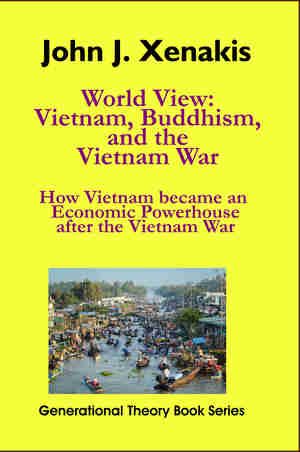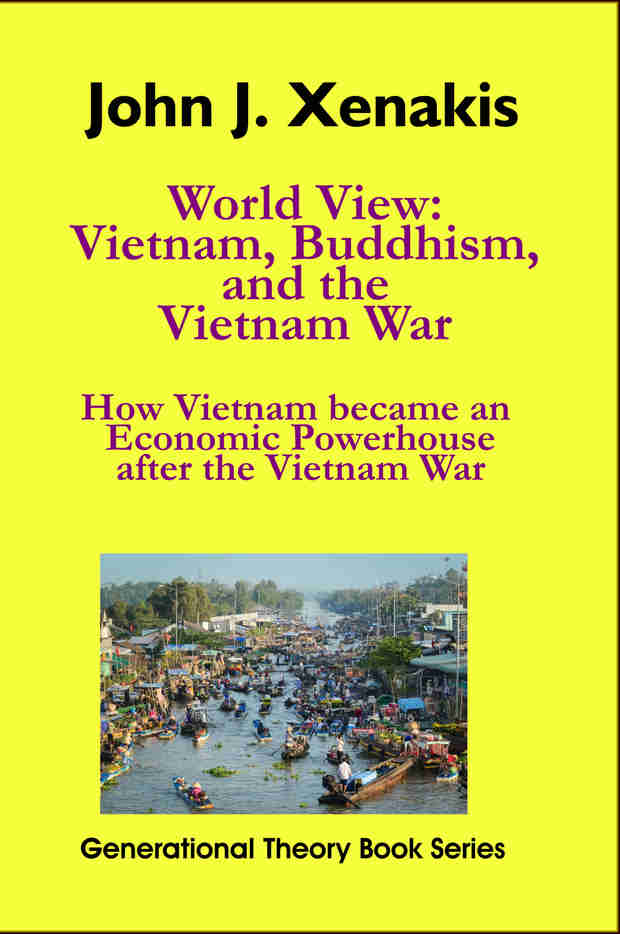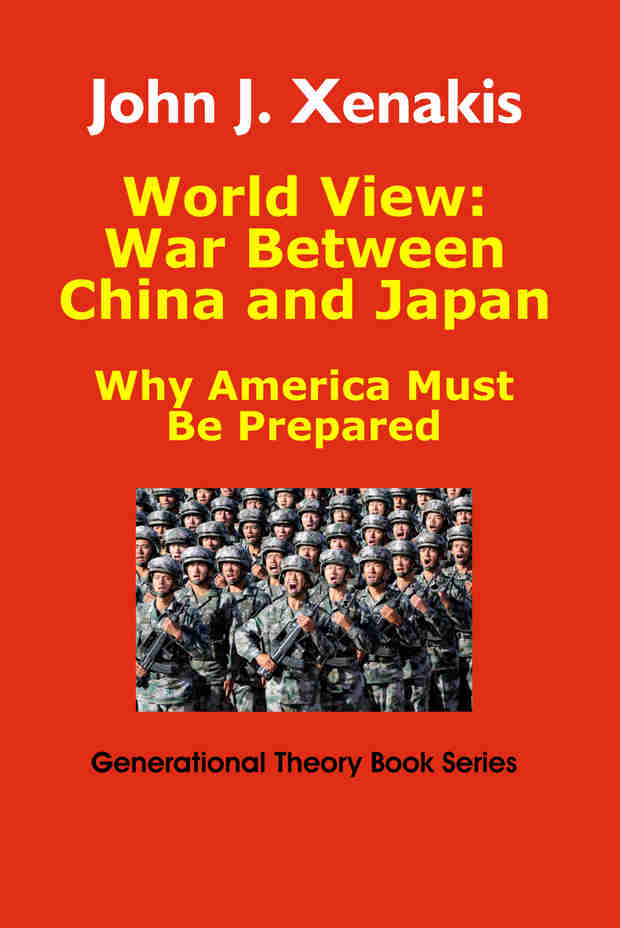
Dynamics

|
Generational Dynamics |
| Modern Generational Theory | |
| HOME WEB LOG COUNTRY STUDIES COMMENT FORUM | |
| DOWNLOADS FOURTH TURNING ARCHIVE ABOUT | |
How Vietnam became an economic powerhouse after the Vietnam War
by
John J. Xenakis
This morning's key headlines from GenerationalDynamics.com
Announcing a new book on Vietnam and Buddhism by John J. Xenakis
Book Announcement: World View: Vietnam, Buddhism, and the Vietnam War
Subtitle: How Vietnam became an economic powerhouse after the Vietnam War
 |
Click here for description and Complete Table of Contents
If you buy it, please write a 5-star amazon review. Thanks.
Most people know nothing about Vietnam except that their grandfathers fought in something called "the Vietnam War." And yet, as guardian of the maritime routes from Europe to India, Malaya and China, Vietnam has for millennia been a dominant player in world trade.
And now, with China illegally annexing the South China Sea, which controls $1.3 trillion in trade, Vietnam's historic role as guardian of the South China Sea could bring the two countries to full war, for the first time in thirty years.
This book describes Vietnam's history since ancient times, through rule by China, through independence, through multiple dynasties, through colonization by France, and through the Indochina wars since World War II, before becoming an economic powerhouse. Those seriously interested in living in or doing business in Vietnam should understand that historically it's not a country in the European sense, but is composed of "Vietnam Villages" that define its culture and business dealings, and should understand the interaction between Buddhism, Confucianism, and Christianity in the villages and guilds.
The book has extensive coverage of the history and theology of Buddhism, and how it spread from India to Vietnam and China, in one of the most sigificant events in the history of religion. The book explains how this was possible because of the specific interactions of Buddhism, Daoism and Confucianism, and how Chinese and Vietnamese leaders played one religion off of one another as needed to control the population. In today's Vietnam, these tensions still exist, especially between North and South.
The author's previous book on the history of Iran has extensive coverage of the history and theology of Islam and Christianity, while his book on China does the same for Confucianism and Daoism. Putting the three books together provides a comprehensive understanding of the world's religions.
The book also has extensive coverage of what "really happened" in the Vietnam war. Most people, even those who fought in the war, or who had family and friends who fought in the war, nonetheless have no idea what the Vietnam War was about. Even Vietnamese people under age 50 don't know what it was about. This book will tell you what actually happened -- not what the politicians and ideologues say happened, but what actually did happen, and why it happened.
I set up the GenerationalDynamics.com web site in 2003 as an experiment, as I stated at the time. I would analyze current and historical events through generational theory and Generational Dynamics. I would make forecasts and predictions, and the articles would remain on my web site for review at any time.
Now, almost 20 years later, there are over 6,000 articles on my web site, containing thousands of analyses and predictions on hundreds of countries, all of which are either true or trending true. None has been shown to be wrong. There is no web site in the world with a better successful forecasting and analysis record than mine, and there is no politician, analyst or journalist with a better forecasting and analysis record than mine.
There are now four books in the Generational Theory Book Series.
 |
"World View: Vietnam, Buddhism, and the Vietnam War: How Vietnam became an economic powerhouse after the Vietnam War" (Generational Theory Book Series, Book 4), March 2021 Paperback: 325 pages, over 200 source references, $13.99 https://www.amazon.com/dp/1732738645/
 |
"World View: War Between China and Japan: Why America Must Be Prepared" (Generational Theory Book Series, Book 2), June 2019 Paperback: 331 pages, over 200 source references, $13.99 https://www.amazon.com/World-View-Between-Prepared-Generational/dp/1732738637/
 |
"World View: Iran's Struggle for Supremacy -- Tehran's Obsession to Redraw the Map of the Middle East" (Generational Theory Book Series, Book 1), September 2018 Paperback: 153 pages, over 100 source references, $7.00 https://www.amazon.com/World-View-Supremacy-Obsession-Generational/dp/1732738610/
 |
"Generational Dynamics Anniversary Edition - Forecasting America's Destiny", (Generational Theory Book Series, Book 3), January 2020, Paperback: 359 pages, $14.99, https://www.amazon.com/Generational-Dynamics-Anniversary-Forecasting-Americas/dp/1732738629/
Table of Contents - World View: Vietnam, Buddhism, and the Vietnam War
Part I. Vietnam, Buddhism and the Vietnam War -- Vietnam today Chapter 1. Importance of Vietnam Chapter 2. Overview of Contents Chapter 3. Objectives of this book Chapter 4. Description of Buddhist theology Chapter 5. Getting a 'feel' for Vietnam 5.1. Vietnam country names Chapter 6. Brief summary of generational eras
Part II. Vietnam's Doi Moi economic reforms (1986-present) Chapter 7. Vietnam's legal and economic history 7.1. Nations, kingdoms, empires, leaders, kings, emperors, dynasties 7.2. Economic influences in historical Vietnam 7.3. Vietnam's economy after French colonization (1858) 7.4. Social etiquette Chapter 8. The collapse of Communism, Socialism, Marxism in Asia 8.1. China -- Mao Zedong's Great Leap Forward 8.2. Russia -- Perestroika and Glasnost 8.3. South Korea, Taiwan, Singapore, and Hong Kong -- the 'Asian Tigers' 8.4. The Doi Moi economic reforms Chapter 9. Details of Doi Moi reforms 9.1. Reforming centrally-planned to market oriented economy 9.2. Land reform 9.3. Abolishing the dual-pricing system 9.4. Foreign Direct Investment (FDI) 9.5. Financial crisis in 2009-12 Chapter 10. Vietnam's economic crisis during Wuhan Coronavirus pandemic (2020) 10.1. Vietnam focuses on foreign investment and trade 10.2. Government heightened focus on high tech and artificial intelligence 10.3. Human Rights
Part III. Overview of Asian religions and theology Chapter 11. Evolution of great religions 11.1. Evolutionary framework of great religions 11.2. Documentation -- written law of the great religions 11.3. Written law in Hinduism and Buddhism 11.4. Etiquette in engaging with Buddhists Chapter 12. Overview of Buddhist theology 12.1. Achieving Nirvana 12.2. Theravada Buddhism ('Path of the Elders') 12.3. Mahayana Buddhism ('The Great Vehicle') 12.4. Hinayana Buddhism ('Modest Vehicle') Chapter 13. The school of meditation: Ch'an / Zen Buddhism 13.1. Rise of Ch'an/Zen Buddhism in China 13.2. Philosophy of Daoism 13.3. Ch'an / Zen Buddhism and sudden enlightenment 13.4. Zen Buddhism in the West Chapter 14. Other schools of Buddhism 14.1. The evolution and simplification of Buddhism 14.2. Pure Land Buddhism 14.3. Tantric (Vajrayana, Tibetan) Buddhism 14.4. Bodhisattvas in Mahayana Buddhism 14.5. The Maitreya in Buddhism
Part IV. How Hinduism and Buddhism spread from India to southern Vietnam Chapter 15. Aryan invasion, and rise of Hinduism in India 15.1. Life of The Buddha (563-483 BC) 15.2. The Middle Way and Enlightenment 15.3. Hinduism and Buddhism 15.4. Popularity of Buddhism Chapter 16. Legacy of Emperor Ashoka (304-232 BC, Ruled 273-232 BC) 16.1. Ashoka commits genocide and ethnic cleansing 16.2. Ashoka repents and converts to Buddhism 16.3. Spread of Buddhism north and south -- overview 16.4. Ashoka's influence on Buddhism Chapter 17. Spread of Theravada Buddhism to southeast Asia and southern Vietnam 17.1. Spread of Buddhism to Ceylon (Sri Lanka) 17.2. Spread of Buddhism to Burma (Myanmar) and Siam (Thailand) 17.3. Spread of Buddhism to Malay Peninsula and Indonesia 17.4. Spread of Buddhism to Cambodia and southern Vietnam (Mekong Delta)
Part V. How Buddhism spread through China to northern Vietnam Chapter 18. Spread of Mahayana Buddhism along the Great Silk Road Chapter 19. Collapse of China's glorious Han Dynasty (206 BC – 220 AD) 19.1. Significance of China's Han Dynasty (206 BC – 220 AD) 19.2. Decline of the Han Dynasty in the 100s 19.3. Collapse of the Han Dynasty -- Yellow Turban Rebellion - 184 AD Chapter 20. Changes to Daoism and Buddhism during and after Han Dynasty 20.1. Daoism during and after the declining Han Dynasty 20.2. Buddhism during and after the declining Han Dynasty 20.3. Differences between Chinese and Indian languages and culture 20.4. Role of Daoism in linking Indian and Chinese cultures Chapter 21. Sacking by the Huns (311) -- China splits into North and South Chapter 22. Spread of Buddhism south of the Yangtze River 22.1. Buddhism vs Confucianism and Daoism Chapter 23. Spread of Buddhism north of the Yangtze River 23.1. Northern rulers' adoption of Buddhism 23.2. Northern rulers' misgivings about Buddhism 23.3. Emancipation of Buddhist ideas from Daoism in the North Chapter 24. Spread of Buddhism in Sui and Tang dynasties (589-906) 24.1. Divergence of North and South during period of disunion 24.2. Regulation of religions during Sui-Tang dynasties 24.3. Great Buddhist movements during Sui-Tang dynasties 24.4. The school of meditation: Ch'an or Zen Buddhism 24.5. The catastrophic An Lu-shan Rebellion (755-763) 24.6. Union of Uighurs and Tibetans (765) 24.7. The Great Suppression of Buddhism (842-845) 24.8. Revival of Confucianism Chapter 25. Zen Buddhism in Japan 25.1. The Zen Koan: What is the sound of one hand clapping? Chapter 26. Buddhism in Vietnam 26.1. Adulteration / Syncretism of Buddhism in Vietnam 26.2. Vietnam Communist Party hostility to religion
Part VI. South Vietnam's ancient history Chapter 27. Background: Archaeological ages and Geography 27.1. Archaeological ages 27.2. Stone age 27.3. Bronze age 27.4. Iron age 27.5. Vietnam's fusion of races, languages and cultures 27.6. Vietnam's Geography Chapter 28. South Vietnam's ancient civilizations -- Sa Huynh, Dong Son 28.1. Sa Huynh culture (10000 BC - 200 AD) 28.2. Dong Son (Dong Son) culture 28.3. Growth of Dong Son culture 28.4. China-Vietnam disputes over Dong Son cultures
Part VII. The millennium of Chinese rule (111 BC to 938 AD) -- Viets, Funan, Champa, Khmers Chapter 29. North Vietnam: Confucian Viet culture, following conquest by China 29.1. Chinese invasion and conquest (111 BC) 29.2. Confucianism in Vietnam and role of women 29.3. Trung Sisters Rebellion (40-43 AD) and reconquest by China 29.4. The Sinicization of North Vietnam 29.5. Ly Bi overthrows Chinese rule, creates Van Xuan empire (544-603) 29.6. Chinese rule by China's Tang dynasty (618-906) Chapter 30. Chinese rule ends with spectacular Battle of Bach Dang River (938) 30.1. Ngo Quyen defeats Chinese in the spectacular Battle of Bach Dang River (938) 30.2. Dinh Bo Linh's tributary mission to China (968) Chapter 31. Far Southern Vietnam: Rise of Hinduized Funan culture, centered in Cambodia 31.1. Funan Culture and Oc-Eo port city Chapter 32. Central Vietnam: Rise of Champa culture 32.1. Champa culture 32.2. Cham people today
Part VIII. Nine centuries of Vietnam independence -- 938 - 1862 Chapter 33. Reference list of Vietnamese dynasties after independence Chapter 34. Vietnam villages 34.1. Vietnam's guilds and villages 34.2. Village organization Chapter 35. Brief history of Laos Chapter 36. Early Le Dynasty (980-1005) 36.1. Generational summary 36.2. Defeating another Chinese invasion Chapter 37. The First Great Dynasty: The Later Ly Dynasty (1009–1225) 37.1. Generational summary 37.2. Development of agriculture in Red River Delta -- and southward move 37.3. Development of written law 37.4. Growth of Buddhism in Nam Viet 37.5. Buddhism in central and south Vietnam 37.6. Champa Kingdom conquest by Angkor Khmers (Cambodia) (1203-20) 37.7. Cultural differences: Nam Viet vs Champa Chapter 38. The Second Great Dynasty -- The Tran Dynasty (1225-1400) 38.1. Generational summary 38.2. Mobilizing eunuchs and slaves - preparing for war 38.3. Sacking of Champa capital Vijaya (1252) 38.4. First Mongol War (1257) 38.5. The Tran vs the Mongols [1284-1287] 38.6. Tran Dynasty defeats the Mongols (1284, 1287) 38.7. Mongols face Vietnamese war elephants (1284) 38.8. Tran soldiers defeat Mongols in Battle of Bach Dang (1287) 38.9. Tran war with Champa (1312) 38.10. Buddhism vs Confucianism during the Tran dynasty 38.11. Growth of Confucianism to modern times Chapter 39. Ho Dynasty (1400-1407) -- Vietnam's most hated dynasty 39.1. Ho general usurps the throne 39.2. China invades Vietnam in brutal period of governance 39.3. Ho Dynasty echoes through Vietnam's history 39.4. War with the Chinese (1417-1427) Chapter 40. Later Le Dynasty Part 1: destruction of Champa Kingdom (1428-1527) 40.1. Generational summary 40.2. Destruction of Champa Kingdom (1471) 40.3. Southern expansion (nam-tien) and land settlement (don dien) 40.4. Aftermath of the destruction of Champa kingdom 40.5. Decline of the Le Dynasty (1497-1527) Chapter 41. Later Le Dynasty Part 2: The warring warlords (1527-1787) 41.1. Generational summary 41.2. The Mac family and Nguyen family split Vietnam in two (1527-45) 41.3. Trinh family joins the struggle (1545-1592) 41.4. Arrival of the Europeans - 1600s 41.5. The inevitable war between Nguyen and Trinh begins (1620-1672) Chapter 42. The cataclysmic Tay-Son Rebellion (1771-1790, defeated 1802) 42.1. Background to Tay-Son Rebellion 42.2. The Ho (Nguyen) brothers begin the Tay-Son rebellion 42.3. Marxist Socialism before Marx -- Tay-Son rebellion 42.4. Tay-Son rebels align themselves with Chinese pirates 42.5. Socialism in the 21st century -- Memories of the Tay-Son rebellion Chapter 43. Nguyen Phuc Anh (Gia Long) launches a harsh new Nguyen Dynasty 43.1. List of kings of the Nguyen Dynasty 43.2. Generational summary 43.3. Nguyen Phuc Anh defeats the Tay-Son rebels (1776-1802) 43.4. Vietnam finally adopts the name Viet Nam 43.5. The Nguyen Dynasty (1802-1945) 43.6. Nguyen Dynasty and persecution of Christians
Part IX. The Treaty of Saigon and French colonization (1862-1954) Chapter 44. Treaty of Saigon, June 1862 44.1. France completes conquest of French Indochina (1887) Chapter 45. Conflicts during French colonization 45.1. Vietnam Villages during French colonization 45.2. Vietnam government after the Treaty of Saigon (1862-1954) 45.3. Truong Dinh -- anti-French guerrilla movement (1858-64) 45.4. Anti-Catholic violence 45.5. Vietnamese modernization movements opposing French colonialism Chapter 46. Rise of Vietnam nationalism up to World War II 46.1. Phan Boi Chau and the Rise of Nationalism (1904) 46.2. Did Ho Chi Minh betray Phan Boi Chau? 46.3. Rise of Ho Chi Minh and fight for independence from the French 46.4. European migration to French Indochina until 1945
Part X. Understanding the context of America's 'Vietnam War' Chapter 47. Summary of America's Vietnam War Chapter 48. Major findings about America's Vietnam War 48.1. Disastrous decisions by President Kennedy 48.2. The question of insanity 48.3. The question of sophistry 48.4. Facts and events vs Context 48.5. Was the Vietnam War worth the cost? Chapter 49. Major world events as context of Vietnam War 49.1. March of Communism 49.2. North Vietnam's toxic relationships with China and Soviet Russia 49.3. Vietcong insurgency in South Vietnam 49.4. Laos coup and the 'Ho Chi Minh Trail' Chapter 50. Insanity and Greek Tragedy 50.1. Understanding Greek Tragedy 50.2. Insanity 50.3. Aeschylus and Prometheus 50.4. The relevance of Greek Tragedy 50.5. The Vietnam War and Greek Tragedy 50.6. Setting the scene in 1959-60 -- the seeds of future defeat 50.7. The main characters Chapter 51. Generational issues 51.1. The Vietnam War and American generations 51.2. Public moods in Vietnam, France and America after WW II 51.3. Hannah Arendt -- 'the calm that settles after all hopes have died' 51.4. Communism on the march -- and the 'Iron Curtain' 51.5. The Truman Doctrine makes America Policeman of the World (1947) 51.6. Truman receives NSC-68 report calling for Soviet Communist 'containment' (April 14, 1950) 51.7. Communist North Korea invades South Korea (June 25, 1950) 51.8. President Eisenhower explains the Domino Theory (1954) 51.9. President Kennedy's 'ask not' inauguration speech (1961) Chapter 52. From trauma in World War II to a Generation Gap in the 1960s 52.1. The traumatic World War II 52.2. Lessons learned: New laws and institutions after WW II 52.3. Definition of the 'Generation Gap' 52.4. The Summer of Love (1967) 52.5. America's generational Awakening era -- 1960s-1970s 52.6. Generation Gap resolution -- Awakening Climax Chapter 53. Examples of generational Recovery and Awakening Eras 53.1. America after World War II (1945) 53.2. Iran after Great Islamic Revolution (1979) 53.3. Zimbabwe after war of independence (1980) 53.4. China after the Communist Revolution (1949) 53.5. American Civil War (1865) 53.6. America's Revolutionary War (1782) 53.7. Japan after the Meiji Restoration (1868) 53.8. Japan after World War II (1945) 53.9. The generational 'Democide Pattern' Chapter 54. The political debate over America's 'Vietnam War' 54.1. The left-wing antiwar view of the Vietnam war 54.2. The Vietnamese view of the Vietnam war 54.3. America allies with Ho Chi Minh in World War II Chapter 55. Overview of the Vietnam War
Part XI. French Indochina War (First Indochina War, Nov 1946 to Aug 1954) Chapter 56. Beginnings of the war Chapter 57. Vietminh strategy Chapter 58. Battle of Dien Bien Phu
Part XII. Interwar period -- 1954-1959 -- Republic of Vietnam Chapter 59. Disagreements between China and Vietnam over who gets the credit Chapter 60. History of persecution of Catholics Chapter 61. North-South migration after First Indochina war Chapter 62. Land reform program Chapter 63. Beginnings of American military involvement Chapter 64. Le Duan replaces Ho Chi Minh as de facto North Vietnam leader 64.1. Legacy of Le Duan (1908-1986) 64.2. Rise of Le Duan Chapter 65. North Vietnam ratifies Resolution 16, authorizing war with the South (May 1959)
Part XIII. Second Indochina War 1959-1975 (America's "Vietnam War") Chapter 66. Conflicts between Washington and Saigon 66.1. Core issues - John Kennedy and William Averell Harriman 66.2. Kennedy's youth and inexperience 66.3. Two peoples, quite apart in culture, thrown together against a common enemy 66.4. Ngo Dinh Diem and South Vietnam's imperfect democracy 66.5. America's conflicting values and policies 66.6. America's conflicting policies in Vietnam under Eisenhower 66.7. Kennedy's disastrous international agreement on Laos 66.8. The Bay of Pigs invasion of Cuba (April, 1961) Chapter 67. Conflicting counterinsurgency (COIN) strategies 67.1. Summary of conflicting counterinsurgency (COIN) strategies 67.2. Counterinsurgency (COIN) military doctrine 67.3. Clear-hold-build counterinsurgency framework Chapter 68. Antecedents of Vietnam's Strategic Hamlet program 68.1. Description of the resettlement strategy for COIN operations 68.2. Boer War (1899-1902) resettlement operations for counterinsurgency 68.3. The Malayan Emergency (1948-55) counterinsurgency (COIN) program Chapter 69. Vietnam's Strategic Hamlet counterinsurgency (COIN) program 69.1. Mixed success of strategic hamlet program Chapter 70. Military coup and assassination of Ngo Dinh Diem 70.1. Eruption of Buddhist-Catholic conflict (summer 1963) 70.2. Rise of antiwar activism and assassination of Diem (1963) 70.3. Summary: Kennedy's two acts of sabotage of the Vietnam War effort 70.4. Sabotage of the Strategic Hamlet program by Hanoi Chapter 71. Why did the Strategic Hamlets program fail? 71.1. Ethnic and linguistic purity in Malaya and Vietnam 71.2. Ethnic and linguistic purity in Boer War 71.3. Counterinsurgency operations in Iraq War and Afghanistan War 71.4. Ethnic and linguistic purity issue in Afghanistan Chapter 72. Lyndon Johnson's war (1964-1967) 72.1. Battle of Ia Drang (November 14-18, 1965) 72.2. Chaos in Saigon -- Buddhists vs Catholics 72.3. Was the war already lost in 1964? 72.4. Lyndon Johnson's 'limited war' escalation 72.5. Tet Offensive, January 1968 72.6. The My Lai Massacre (March 16, 1968) 72.7. Korean soldiers in Vietnam war Chapter 73. Nguyen Van Thieu and the Second Republic of Vietnam (1967-1975) 73.1. Creation of the Second Republic (1967) 73.2. American policy mistakes in Vietnam 73.3. Problems facing Richard Nixon 73.4. Nixon's 'Vietnamization' policy 73.5. The Cambodia incursion 73.6. The Paris Peace Agreement - October 1972 73.7. The collapse of South Vietnam 73.8. Le Duan's victory speech (May 15, 1975)
Part XIV. Vietnam - Cambodia - China war (Third Indochina War, 1975-1989) Chapter 74. Overview of the so-called 'Vietnam War' Chapter 75. Richard Nixon's 'decent interval' policy Chapter 76. North Vietnamese post-war massacres and boat people (1975-85) Chapter 77. Pol Pot and the Cambodian 'Killing Fields' by the Khmer Rouge 77.1. Rise of Pol Pot and the Khmer Rouge in Cambodia 77.2. Pol Pot's Killing Fields -- one of the worst genocides of the 20th century 77.3. War between Vietnamese and Khmer Rouge (supported by the Chinese Communists) 77.4. Cambodia invades Vietnam (1977) 77.5. Hanoi attacks the Chinese population in Vietnam (1978) 77.6. Collapse of Vietnam's economy (1978) 77.7. History of China and Russia wars and border conflicts 77.8. Vietnam invades Cambodia 77.9. China invades Vietnam (1979-89) 77.10. Le Duan dies and Vietnam opens its markets - Doi Moi (1986)
Part XV. References lists Chapter 78. Reference list of names for Vietnam Chapter 79. Reference list of Vietnam's dynasties Chapter 80. Reference list of 54 Vietnamese Ethnic Groups 80.1. Eight categories of Vietnamese ethnic groups 80.2. Alphabetical list of Vietnam's 54 ethnic groups Chapter 81. Reference list of China's dynasties
Part XVI. Histories of Vietnam's neighbors Chapter 82. History of Philippines 82.1. China's history with the Philippines 82.2. Ancient history of the Philippines 82.3. Philippines Spanish colonial period (1521-1898) 82.4. Philippines under American control (1898-1946) and Japanese occupation (1941-45) 82.5. Modern generational history of the Philippines republic Chapter 83. Brief generational history of Cambodia Chapter 84. Brief generational history of Thailand Chapter 85. Brief generational history of Myanmar (Burma)
Part XVII. The End Chapter 86. About John J. Xenakis 86.1. Acknowledgments
Part XVIII. Footnotes / References
(Comments: For reader comments, questions and discussion,
see the Generational Dynamics World View News thread of the Generational
Dynamics forum. Comments may be posted anonymously.)
(23-Mar-2021)
Permanent Link
Receive daily World View columns by e-mail
Donate to Generational Dynamics via PayPal
Web Log Summary - 2021
Web Log Summary - 2020
Web Log Summary - 2019
Web Log Summary - 2018
Web Log Summary - 2017
Web Log Summary - 2016
Web Log Summary - 2015
Web Log Summary - 2014
Web Log Summary - 2013
Web Log Summary - 2012
Web Log Summary - 2011
Web Log Summary - 2010
Web Log Summary - 2009
Web Log Summary - 2008
Web Log Summary - 2007
Web Log Summary - 2006
Web Log Summary - 2005
Web Log Summary - 2004
Web Log - December, 2021
Web Log - November, 2021
Web Log - October, 2021
Web Log - September, 2021
Web Log - August, 2021
Web Log - July, 2021
Web Log - June, 2021
Web Log - May, 2021
Web Log - April, 2021
Web Log - March, 2021
Web Log - February, 2021
Web Log - January, 2021
Web Log - December, 2020
Web Log - November, 2020
Web Log - October, 2020
Web Log - September, 2020
Web Log - August, 2020
Web Log - July, 2020
Web Log - June, 2020
Web Log - May, 2020
Web Log - April, 2020
Web Log - March, 2020
Web Log - February, 2020
Web Log - January, 2020
Web Log - December, 2019
Web Log - November, 2019
Web Log - October, 2019
Web Log - September, 2019
Web Log - August, 2019
Web Log - July, 2019
Web Log - June, 2019
Web Log - May, 2019
Web Log - April, 2019
Web Log - March, 2019
Web Log - February, 2019
Web Log - January, 2019
Web Log - December, 2018
Web Log - November, 2018
Web Log - October, 2018
Web Log - September, 2018
Web Log - August, 2018
Web Log - July, 2018
Web Log - June, 2018
Web Log - May, 2018
Web Log - April, 2018
Web Log - March, 2018
Web Log - February, 2018
Web Log - January, 2018
Web Log - December, 2017
Web Log - November, 2017
Web Log - October, 2017
Web Log - September, 2017
Web Log - August, 2017
Web Log - July, 2017
Web Log - June, 2017
Web Log - May, 2017
Web Log - April, 2017
Web Log - March, 2017
Web Log - February, 2017
Web Log - January, 2017
Web Log - December, 2016
Web Log - November, 2016
Web Log - October, 2016
Web Log - September, 2016
Web Log - August, 2016
Web Log - July, 2016
Web Log - June, 2016
Web Log - May, 2016
Web Log - April, 2016
Web Log - March, 2016
Web Log - February, 2016
Web Log - January, 2016
Web Log - December, 2015
Web Log - November, 2015
Web Log - October, 2015
Web Log - September, 2015
Web Log - August, 2015
Web Log - July, 2015
Web Log - June, 2015
Web Log - May, 2015
Web Log - April, 2015
Web Log - March, 2015
Web Log - February, 2015
Web Log - January, 2015
Web Log - December, 2014
Web Log - November, 2014
Web Log - October, 2014
Web Log - September, 2014
Web Log - August, 2014
Web Log - July, 2014
Web Log - June, 2014
Web Log - May, 2014
Web Log - April, 2014
Web Log - March, 2014
Web Log - February, 2014
Web Log - January, 2014
Web Log - December, 2013
Web Log - November, 2013
Web Log - October, 2013
Web Log - September, 2013
Web Log - August, 2013
Web Log - July, 2013
Web Log - June, 2013
Web Log - May, 2013
Web Log - April, 2013
Web Log - March, 2013
Web Log - February, 2013
Web Log - January, 2013
Web Log - December, 2012
Web Log - November, 2012
Web Log - October, 2012
Web Log - September, 2012
Web Log - August, 2012
Web Log - July, 2012
Web Log - June, 2012
Web Log - May, 2012
Web Log - April, 2012
Web Log - March, 2012
Web Log - February, 2012
Web Log - January, 2012
Web Log - December, 2011
Web Log - November, 2011
Web Log - October, 2011
Web Log - September, 2011
Web Log - August, 2011
Web Log - July, 2011
Web Log - June, 2011
Web Log - May, 2011
Web Log - April, 2011
Web Log - March, 2011
Web Log - February, 2011
Web Log - January, 2011
Web Log - December, 2010
Web Log - November, 2010
Web Log - October, 2010
Web Log - September, 2010
Web Log - August, 2010
Web Log - July, 2010
Web Log - June, 2010
Web Log - May, 2010
Web Log - April, 2010
Web Log - March, 2010
Web Log - February, 2010
Web Log - January, 2010
Web Log - December, 2009
Web Log - November, 2009
Web Log - October, 2009
Web Log - September, 2009
Web Log - August, 2009
Web Log - July, 2009
Web Log - June, 2009
Web Log - May, 2009
Web Log - April, 2009
Web Log - March, 2009
Web Log - February, 2009
Web Log - January, 2009
Web Log - December, 2008
Web Log - November, 2008
Web Log - October, 2008
Web Log - September, 2008
Web Log - August, 2008
Web Log - July, 2008
Web Log - June, 2008
Web Log - May, 2008
Web Log - April, 2008
Web Log - March, 2008
Web Log - February, 2008
Web Log - January, 2008
Web Log - December, 2007
Web Log - November, 2007
Web Log - October, 2007
Web Log - September, 2007
Web Log - August, 2007
Web Log - July, 2007
Web Log - June, 2007
Web Log - May, 2007
Web Log - April, 2007
Web Log - March, 2007
Web Log - February, 2007
Web Log - January, 2007
Web Log - December, 2006
Web Log - November, 2006
Web Log - October, 2006
Web Log - September, 2006
Web Log - August, 2006
Web Log - July, 2006
Web Log - June, 2006
Web Log - May, 2006
Web Log - April, 2006
Web Log - March, 2006
Web Log - February, 2006
Web Log - January, 2006
Web Log - December, 2005
Web Log - November, 2005
Web Log - October, 2005
Web Log - September, 2005
Web Log - August, 2005
Web Log - July, 2005
Web Log - June, 2005
Web Log - May, 2005
Web Log - April, 2005
Web Log - March, 2005
Web Log - February, 2005
Web Log - January, 2005
Web Log - December, 2004
Web Log - November, 2004
Web Log - October, 2004
Web Log - September, 2004
Web Log - August, 2004
Web Log - July, 2004
Web Log - June, 2004